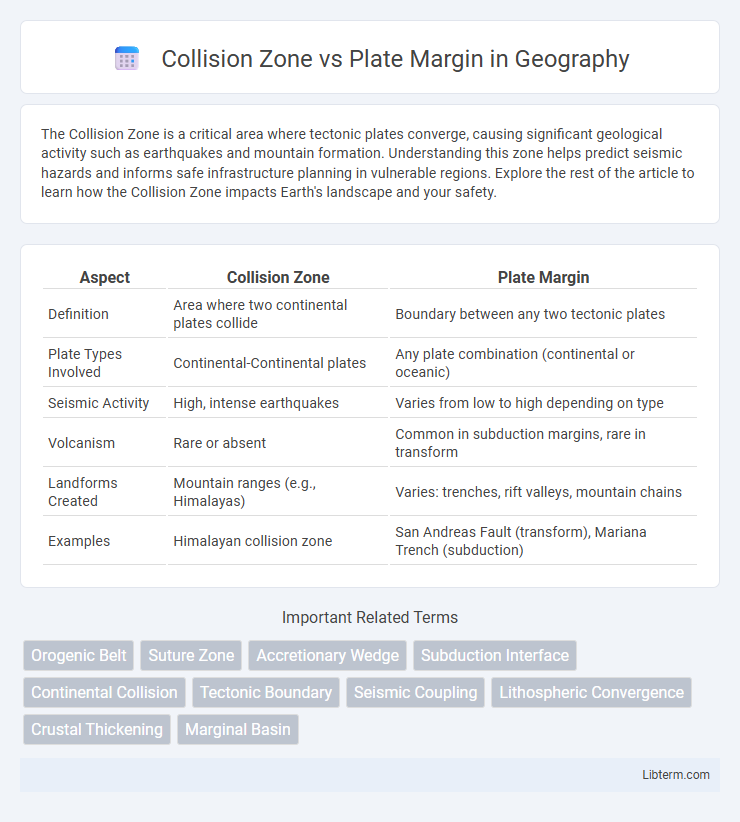The Collision Zone is a critical area where tectonic plates converge, causing significant geological activity such as earthquakes and mountain formation. Understanding this zone helps predict seismic hazards and informs safe infrastructure planning in vulnerable regions. Explore the rest of the article to learn how the Collision Zone impacts Earth's landscape and your safety.
Table of Comparison
| Aspect | Collision Zone | Plate Margin |
|---|---|---|
| Definition | Area where two continental plates collide | Boundary between any two tectonic plates |
| Plate Types Involved | Continental-Continental plates | Any plate combination (continental or oceanic) |
| Seismic Activity | High, intense earthquakes | Varies from low to high depending on type |
| Volcanism | Rare or absent | Common in subduction margins, rare in transform |
| Landforms Created | Mountain ranges (e.g., Himalayas) | Varies: trenches, rift valleys, mountain chains |
| Examples | Himalayan collision zone | San Andreas Fault (transform), Mariana Trench (subduction) |
Introduction to Collision Zones and Plate Margins
Collision zones and plate margins represent key interactions between tectonic plates, where dynamic geological processes shape the Earth's surface. Collision zones occur when two continental plates converge, forming mountain ranges like the Himalayas, whereas plate margins encompass the broader boundaries where plates interact, including divergent, convergent, and transform types. Understanding these zones is crucial for studying seismic activity, mountain building, and continental drift.
Defining Plate Margins: Types and Characteristics
Plate margins, also known as plate boundaries, are the edges where two tectonic plates meet, classified into three main types: divergent, convergent, and transform margins. Divergent margins involve plates moving apart, causing seafloor spreading and the formation of mid-ocean ridges, while convergent margins, including collision zones, arise from plates moving toward each other, resulting in subduction zones or mountain-building events. Transform margins are characterized by plates sliding past each other horizontally, creating strike-slip faults and frequent seismic activity.
What is a Collision Zone?
A collision zone is a tectonic boundary where two continental plates converge, resulting in the crust thickening and forming mountain ranges such as the Himalayas. Unlike divergent or transform plate margins, collision zones generate intense seismic activity and crustal deformation due to the compressional forces involved. This process contrasts with other plate margins where plates either move apart or slide past each other without significant crustal uplift.
Key Differences: Collision Zone vs Other Plate Margins
Collision zones form where two continental plates converge, generating significant mountain ranges such as the Himalayas due to intense crustal thickening and compression. In contrast, divergent plate margins involve plates moving apart, leading to seafloor spreading and the formation of mid-ocean ridges like the Mid-Atlantic Ridge. Transform plate margins are characterized by lateral sliding of plates past one another, causing earthquake activity along fault lines such as the San Andreas Fault.
Plate Tectonic Processes in Collision Zones
Collision zones are specific types of plate margins where two continental plates converge, leading to intense tectonic processes such as crustal thickening, mountain building, and seismic activity. These processes result from the compressional forces that cause folding, faulting, and metamorphism of rocks within the collision zone. Unlike divergent or transform margins, collision zones primarily facilitate crustal shortening and the formation of large orogenic belts like the Himalayas.
Geological Features Formed at Collision Zones
Collision zones create extensive mountain ranges, such as the Himalayas, through the intense compression and folding of continental crust. These regions often exhibit deep crustal roots, high-grade metamorphic rocks, and complex fault systems resulting from the convergence of tectonic plates. Unlike divergent or transform plate margins, collision zones generate significant crustal thickening and uplift, leading to geological features like thrust faults, suture zones, and extensive orogenic belts.
Examples of Major Collision Zones Worldwide
Major collision zones worldwide include the Himalayan region where the Indian Plate collides with the Eurasian Plate, forming the highest mountain range on Earth. Another significant collision zone is the Alpide belt, encompassing the collision between the African Plate and the Eurasian Plate, resulting in mountain systems such as the Alps and the Pyrenees. The Zagros Mountains in Iran represent a prominent collision zone where the Arabian Plate converges with the Eurasian Plate, demonstrating intense seismic and orogenic activity.
Tectonic Activity and Earthquakes at Plate Margins
Collision zones are regions where two continental plates converge, causing intense tectonic activity such as mountain building and frequent, powerful earthquakes due to the immense compressional forces. Plate margins, including divergent, convergent, and transform boundaries, are sites of significant seismic activity as plates interact through subduction, spreading, or lateral sliding. Earthquakes at plate margins result from the release of accumulated stress along faults, making these boundaries hotspots for tectonic movement and seismic hazards.
Economic and Environmental Impacts of Collision Zones
Collision zones, where tectonic plates converge, create significant economic opportunities through mineral resource deposits such as gold, copper, and rare earth elements, fueling mining industries and local economies. Environmental impacts include frequent earthquakes and mountain-building processes that reshape landscapes, disrupt ecosystems, and pose risks to human settlements and infrastructure. These zones also influence water resources by altering river courses and increasing sedimentation, affecting agriculture and biodiversity in the affected regions.
Collision Zones in Plate Tectonic Theory
Collision zones in plate tectonic theory occur where two continental plates converge, creating intense crustal deformation and mountain building, such as the Himalayas formed by the Indian and Eurasian plates. These zones are characterized by thickened crust, high seismic activity, and complex metamorphic processes due to the compressive forces involved. Unlike divergent or transform plate margins, collision zones primarily result in orogeny and crustal shortening rather than seafloor spreading or lateral displacement.
Collision Zone Infographic

 libterm.com
libterm.com